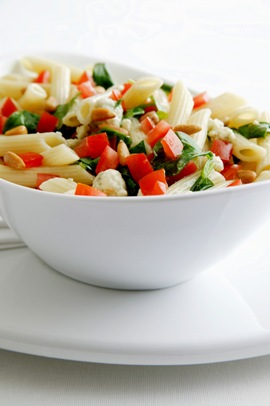Five Produce Items to Watch
15 July 2010Courtesy of The Perishables Group
 Berries, now available year-round, are the largest-selling item in the produce department of grocery stores, and the tomato category has been transformed by newly introduced varieties and innovations in packaging. And then there’s “living” lettuce.
Berries, now available year-round, are the largest-selling item in the produce department of grocery stores, and the tomato category has been transformed by newly introduced varieties and innovations in packaging. And then there’s “living” lettuce.
The fresh-produce industry has changed tremendously in recent years, most notably with the growth of value-added options, new varieties and the proliferation of branding. The Perishables Group, an industry-leading consulting firm in the fresh-foods business, identified five produce items to watch in 2010. These items are evolving and appealing because they capitalize on current trends such as health, convenience and sustainability. Here are the fresh produce items to watch:
Specialty Potatoes
The foodie movement and the popularity of food-centered media have served the specialty-potato category well. Specialty potatoes add color and size variations to dishes, reduce labor and provide faster cooking times.
Tomatoes
Tomatoes are a staple item in kitchens, but the category is rapidly evolving in terms of variety and packaging. Increasing the segmentation brings greater value to the category. This strategy has transformed the tomato category, which was driven primarily by field-grown beefsteak tomatoes just five years ago.
Tomatoes are growing their image as a healthy and convenient snack thanks to sweet varieties such as the Sugardrop, developed by Tesco, and packaging such as the eye-catching dome-shaped plastic container used for Cherub snacking tomatoes. Eurofresh Farms’ Bella Bites are grape-sized tomatoes marketed as a sweet and healthy, pesticide-free snack for kids.
The Kumato tomato, a flavorful brown tomato that has long been popular in Europe, was introduced by Mastronardi into the United States in mid-2009. Mastronardi has already announced that they will double the acreage devoted to producing the Kumato due to its surging popularity. They will also move production to warmer climates so they can produce year-round (Source: The Packer).
Contributing to the category’s progress, leading tomato suppliers are making efforts to increase education about the best tomatoes for various uses and recipes, as many consumers do not have a clear understanding of these fundamentals.
Refrigerated Juices
Refrigerated juices are in a unique position to capitalize on the growing efforts to eat healthier while still maintaining an on-the-go lifestyle.
Many refrigerated juices offer multiple servings of fruit and vegetables in one bottle that can be consumed almost anywhere (and without a fork or spoon).
Though refrigerated juices are often priced relatively high compared to juices sold in center-store, one bottle is still more affordable than purchasing the equal quantity of ingredients.
Sales of refrigerated juice declined last year, but the products are still growing in distribution. Four of the five top refrigerated juice brands experienced a sales drop over the latest 52 weeks ending Sept. 26, 2009; but still combined to generate $300 million in sales.
Refrigerated juices also benefit from their ideal fit into the convenience-store channel. A sales rebound in 2010 is likely as the economy continues to improve.
Living Lettuce
Having launched less than five years ago, living lettuce is warranting attention in the leafy greens section.
Grown hydroponically and packaged with its roots still intact, living lettuce has an extended shelf life of up to 18 days post-harvest and its sustainable growing practices require little to no use of pesticides.
Most people can’t resist the opportunity to have fresh produce that reduces the impact on the environment and eliminates waste, with the added benefit of a longer shelf life. Watch for this item to grow in sales and distribution this year.
Berries
Though the berry category is a long-time staple in the produce department, it has established itself as a force to reckon with in recent years. Total berry dollar sales increased 58% over the past five years, led by blackberries and blueberries with increases of 122% and 87%, respectively.
Berry sales growth can be attributed to the variety and quality of berries that are available throughout the year. Production expanded domestically, with blueberries experiencing notable production growth in Oregon, Washington and Michigan. Mexico, Chile and Argentina are also growing and exporting berries to the United States, extending the availability to year-round.
A second important factor in the growth of the berry category is the significant presence of organic items. Organic berries account for 5.6% of total berry dollar sales, with organic strawberries representing $53.8 million last year.
Finally, the super-food trend, fueled by consumers’ increasing demands for healthy food choices, helped the berry industry, as blueberries and blackberries have some of the highest amounts of antioxidants of all fruits and vegetables.
Berries are now the largest-selling item in the produce department of grocery stores and were one of the few items that grew during the recession.
The fresh-food industry will be watching closely as the economic recovery continues to develop the second half of 2010, with hopes that any changes will benefit fresh produce industry overall.
Source: Perishables Group FreshFacts® Powered by Nielsen, Five-year Historical Data (Projected to 100 percent total U.S. Supermarket ACV)
The Perishables Group is a Chicago-based consulting firm focused on creating innovation and value for clients in the fresh food industry. Perishables Group expertise includes research, analytics, marketing communications, category development, supply-chain management and activity-based costing.
